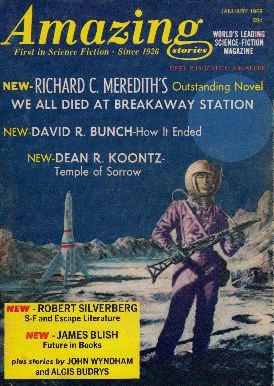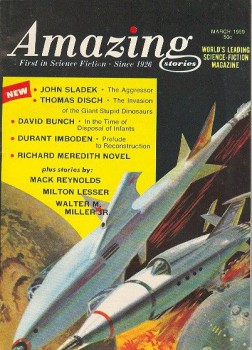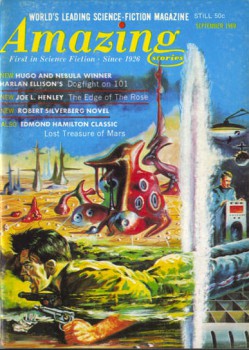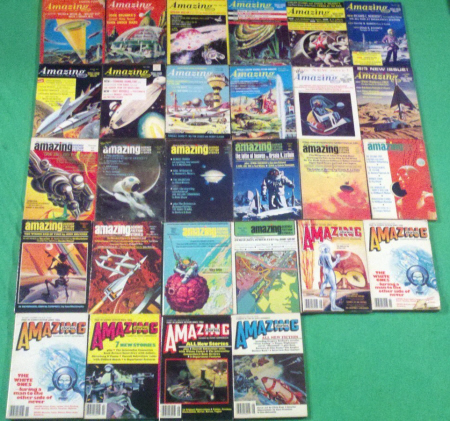Vintage Treasures: The Amazing Space Race
 A few weeks back, I purchased a lot of 27 Amazing Stories digests from the mid-60s and early 70s in great condition, for $35 (including shipping) — or about a buck an issue.
A few weeks back, I purchased a lot of 27 Amazing Stories digests from the mid-60s and early 70s in great condition, for $35 (including shipping) — or about a buck an issue.
This was simultaneously delightful and dismaying. Delightful, of course, to get a fine set of SF magazines for not much more than they cost on the newsstand 45 years ago; dismaying to find that pristine vintage copies of one of the most important SF magazines command such little interest in the market.
Seriously, this doesn’t bode well for the thousands of SF magazines I’ve been gradually accumulating in my basement for the last 35 years. I consider them treasures, but it seems the number of people who share my interest is shrinking every year. I just hope they don’t all end up getting recycled when I shuffle off this mortal coil.
Well, all collectors can really do is delight in those treasures we find, and share our enthusiasm with those around us. To that end, here I am, talking about a handful of issues of Amazing Stories, starting with the January 1969 issue, at left.
The late sixties was a bumpy time for the Granddaddy of Science Fiction magazines. Perhaps its finest editor, the talented Cele Goldsmith, left when the magazine was sold to Sol Cohen’s Ultimate Publishing Company in March 1965. At the time, Ultimate was simultaneously publishing Great Science Fiction, Science Fiction Classics, and other profitable reprint magazines — profitable chiefly because they didn’t pay for any of the reprints. Cohen wanted to pursue a similar strategy with Amazing.
Cohen hired Joseph Wrzos to edit both Amazing and Fantastic magazines, and indeed for several years Amazing offered almost exclusively reprints — although Wrzos reportedly did get Cohen to cough up funds for one new piece of fiction per issue. Wrzos left in 1967, and Harry Harrison was briefly editor from September 1967 to February 1968, when the talented Barry Malzberg stepped into his shoes.
It’s the Malzberg era I’m chiefly concerned with here. Malzberg came into conflict with Cohen almost immediately over the reprints, and you can see the results on the cover of the January 1969 issue, which proudly proclaims several NEW pieces of fiction, including stories by Dean R. Koontz, David R. Bunch, new review columns by Robert Silverberg and James Blish, and the first installment of a two-part serial novel, We All Died at Breakaway Station by Richard C. Meredith.
 The gradual shift from a reprint publication to a living, breathing science fiction magazine wasn’t the only exciting change happening to Amazing. January 1969 was the very height of the Space Race, a scant six months before Neil Armstrong and Buzz Aldrin landed on the moon, when space travel stepped out of the pages of science fiction and planted a foot firmly in the history books.
The gradual shift from a reprint publication to a living, breathing science fiction magazine wasn’t the only exciting change happening to Amazing. January 1969 was the very height of the Space Race, a scant six months before Neil Armstrong and Buzz Aldrin landed on the moon, when space travel stepped out of the pages of science fiction and planted a foot firmly in the history books.
Science Fiction experienced a huge surge in respectability and interest as a result, and magazines like Amazing, which only a year or two earlier had gleefully embraced its pulp roots by reprinting Frank R. Paul covers from the 1920s, made an abrupt shift in tone with cover art that spoke of more contemporary themes, jettisoning Paul’s jet-packs and jolly pool-dwelling aliens for stern-looking marines on stark lunar landscapes, and fighter jets in desperate orbital dogfights.
The flight to quality continued with the March 1968 issue (at right; click for a bigger version). This time the new fiction was from John Sladek, Thomas Disch, and David Bunch, not to mention the conclusion of Meredith’s novel.
This was a pretty stellar line up — for any time period.
In fact, just looking through a handful of issues from 1968-71 reveals a stellar list of authors: Bob Shaw, Randall Garrett, Philip Jose Farmer, Christopher Anvil, Howard L. Myers, Harlan Ellison and Samuel R. Delany, R.A. Lafferty, Theodore Sturgeon, Richard Matheson, Thomas M. Disch, John Sladek, Walter M. Miller, Jr, Mack Reynolds, Milton Lesser, and many others.
There were some great novels, too, most of them published in two parts. In 1969-70 alone Amazing published Meredith’s We All Died at Breakaway Station, Robert Silverberg’s Up the Line (starting in July 1969), Piers Anthony’s Orn (starting in July 1970), and One Million Tomorrows by Bob Shaw (November 1970).
 Malzberg made great strides with the non-fiction as well. In addition to recruiting Silverberg and Blish to handle the review chores, he broke ground with real investigative reporting. The Nov 1970 issue had his famous Dianetics expose, “Dianetics: The Evolution of a Science,” which still makes fascinating reading today.
Malzberg made great strides with the non-fiction as well. In addition to recruiting Silverberg and Blish to handle the review chores, he broke ground with real investigative reporting. The Nov 1970 issue had his famous Dianetics expose, “Dianetics: The Evolution of a Science,” which still makes fascinating reading today.
The issues were 146 pages each (including the front cover in the page count, oddly enough), and thoroughly packed with fiction, reviews, and articles.
The Malzberg era was short-lived, however. He had an argument with Cohen over cover art, and Cohen replaced him with Ted White. Ted took the magazine in a very different direction, and the contents — and the cover art — changed dramatically again.
I’m still working my way through the issues, but I’ve been pleased and fascinated with what I’ve discovered so far. In a scant few years, Amazing went through several dramatic changes; growing up, in effect, from an un-self-conscious pulp remnant to a magazine that reflected America’s fascination with the Space Age, and then just as quickly submerging itself in 70s pop culture, with covers that were clearly more influenced by Marvel Comics than the Space Race.
One final comment on the contents, before I leave you with a panorama of Amazing Stories covers: boy, the font is small. Say what you will about SF readers of the 1960 and 1970s, but they sure had great eyesight.
Below is a snapshot of the set of 27 Amazing issues I purchased, arranged chronologically from 1966 to 1980. This is by no means a complete set of issues spanning those 15 years, but it gives you a nice representative sample. Click on the image for a bigger version, and you can see what I mean about the rapid progression of cover art: from pulp (top row, 1966 to 1969) to Space Age chic (second row, 1969-70) to the beginning of the Ted White era (third row, 1970-71), and finally the mid-70s (last two rows).
This is what 35 bucks can get you — or roughly the cost of that single season of Jersey Shore you purchased on DVD. Just as a point of note. I’m not judging.
View all of our recent Vintage Treasures articles here.

Seeing that one of the issues featured a Dean Koontz story reminded me of the time I saw some of his early Ace Doubles science fiction novels at a local comic shop. Knowing how rare they are, I asked how much they wanted for the books. I was so shocked to be told $10 each that I blurted “That’s all?”
When I was checking out the cashier joked about charging me $100 for each book without realizing that was probably about what those books were worth since Koontz has kept that early stuff out of print for so long.
Ah, that reminds me again … I subscribed to Amazing in the late 70s — the end of the Ted White era. Lots of dross, of course, but some jewels as well. All those title font changes — seemed to imitate Analog of the same era for a while.
The novels of Barry’s period are indeed impressive — Richard Meredith is hardly remembered today, but he did some pretty fun stuff — WE ALL DIED AT BREAKAWAY STATION certainly included. And add stuff by Silverberg, Anthony (pre-Xanth), and Shaw!
Good Stuff!
> Seeing that one of the issues featured a Dean Koontz story reminded me of the time I
> saw some of his early Ace Doubles science fiction novels at a local comic shop.
Amy,
What a find! And indeed, Koontz’s early SF paperbacks are some of the most collectible of the era, as they had small print runs and he has not reprinted them since.
> The novels of Barry’s period are indeed impressive — Richard Meredith is hardly remembered today,
> but he did some pretty fun stuff — WE ALL DIED AT BREAKAWAY STATION certainly included. And add stuff
> by Silverberg, Anthony (pre-Xanth), and Shaw!
Hey Rich,
Impressive, isn’t it?
It was a delight to be sorting through these issues and watch AMAZING flower from a ho-hum reprint mag into a top-tier SF publication in the space of just a few issues.
Not sure how the credit should be split between Harrison, Malzberg, and White, but clearly all three gentlemen deserve kudos for re-making the magazine into something very special.
John,
That’s a great catch! You have to be one happy man.
I started reading amazing back around 1972 (I was 11) and it was an eye opener considering that up until then I had yet to get past Verne, Wells, Clarke, Asimov and Heinlein.
As far as whether or not others are interested in these old treasures, collect for your own joy. I’m afraid that this has become the norm. I remember an article you published a few years ago written by Robert Silverberg (if I remember correctly) discussing this very issue. Younger folks just don’t seem to have much interest in “old stuff”. The readership has been so affected by other media such as films, comics, TV and games of all kinds. I work at the public observatory over here in Nuremberg. It’s pretty much nerd heaven. Yet even though I now many “hardcore” SF and Fantasy fans, most of the folks under 40 have never read any “older writers” such as Disch, Silverberg, Pohl, Sturgeon or even Asimov and Heinlein. And I have to add that all these writers were once a big deal even over here. And none of them needs a monthly dose of Short fiction to make living tolerable.
I can’t speak for the states anymore (I’m from Ohio), but you just have to look at what’s on the Tube. I have the most basic cable package there is with 32 channels and yet it’s a rare day to find a film showing that is older than the 1990s. I think that this is something we will have to get used to. My nightmare is that when the day comes that I’m not around anymore my books will either be tossed out or end up at the flea market for a few cents apiece.
So collect out of love alone. Philistines be damned.
I hope that I’m wrong, but this stuff will probably die with us.
Take care.
Doug.
P.S.
Ted White also did a wonderful job over at “Fantastic”. It was my favorite monthly back then.
I wouldn’t lament the lack of interest in these old magazines. I’m currently trying to collect the first one hundred issues of Dragon Magazine. I would absolutely LOVE for 40 and 50-somethings to lose interest in this magazine. The price tag on the remaining issues I don’t have seems to go up every few months.
As an aside: Does anyone know a seller or website that sells old Dragons? I’m always on the lookout.
> So collect out of love alone. Philistines be damned.
> I hope that I’m wrong, but this stuff will probably die with us.
Doug,
Collecting out of love alone is good advice.
Still, I think collectors should share the things they love. It’s on hobbiests to promote interest in their hobby and keep it alive — otherwise, they have no one but themselves to blame when it dies.
That’s a big part of what I’m trying to do here at Black Gate: promote the things I love and keep them alive. It’s easy to do with comics, games, and novels.
But short fiction and vintage magazines? That seems to be a dying branch of the genre.
Every week on eBay it seems another collector has died, and a huge block of old vintage magazines are put up in an estate sale.
Hence these posts I’m writing. I became a SF magazine collector as a result of reading “2000AD – Illustrations from The Golden Age of Sci Fi Pulps,” an art book by Jacques Sadoul from October 1975:
http://bookscans.com/Publishers/ref-scifi/Reference/2000ad.htm
Sadoul passed his love of pulp collecting along to me with that one book. Perhaps with these posts, I can interest others in the same way.
> I wouldn’t lament the lack of interest in these old magazines. I’m currently
> trying to collect the first one hundred issues of Dragon Magazine. I would absolutely
> LOVE for 40 and 50-somethings to lose interest in this magazine.
James,
Ha! Yeah, that’s certainly the dark side of a popular hobby. 🙂
You’re right, of course. If there was a vibrant interest in old SF digests, those 27 magazines I bought could have cost $350, instead of $35. I should enjoy the fact that my hobby is cheap. 🙂
As for Dragons… interest in that magazine has been oddly cyclical. I started collecting it in the 80s, and prices for the early issues were sky-high. They dropped considerably in the 90s and 2000s, when interest in D&D waned.
I haven’t checked recently, but I’d be surprised if they’ve surged back to the old highs… but anything is possible.
Wow, lovely haul. I have a slight addiction to these old magazines, really love them despite being a little too young to have enjoyed them first time round. I buy them whenever I find them in bookshops, and the odd few from ebay, but the market is much smaller in the UK I think.
It’s worth noting that there are a number of groups on the internet who are digitally preserving them by scanning and archiving. I just hope some of these large collections make it into the hands of the scanners so that future generations get to enjoy them in some form at least. I love the physical product, but many of them were not printed to last.
> I love the physical product, but many of them were not printed to last.
True that. The problem is even worse for pulps – which, by definition, were printed on low-quality pulp stock that frequently disintegrated a year or two after being printed.
The digests I have are sometimes a little yellowed, but by and large they have survived the decades far better than my pulp collection.
John,
Great find! I think it’s odd as well that there isn’t much demand in these old magazines. But then again, I’d rather be able to easily get my hands on them than compete with collectors who will put them in permanent bindings like vintage comic books.
And are you really collecting in hopes of profiting from them anyway? Even if they were valuable, I’ll keep my collection of vintage treasures in my possession until my last will and testament states they go to my next of kin.
[…] Vintage Treasures: The Amazing Space Race […]